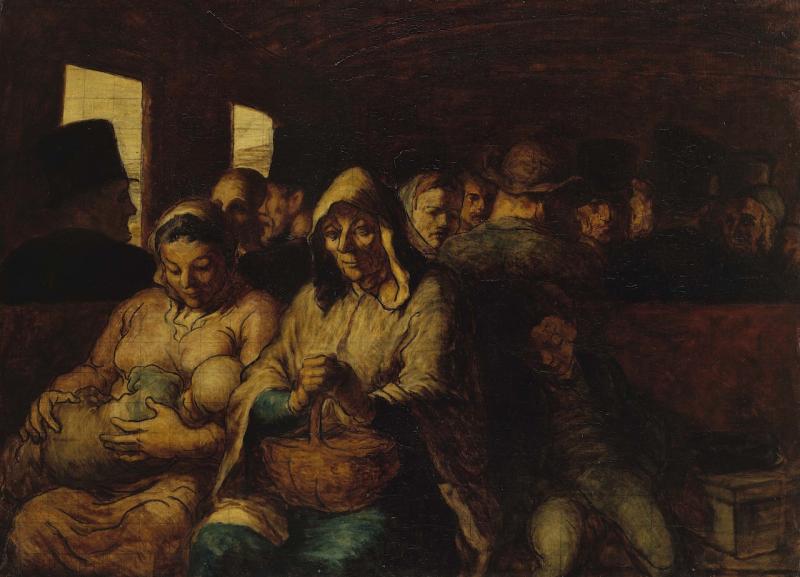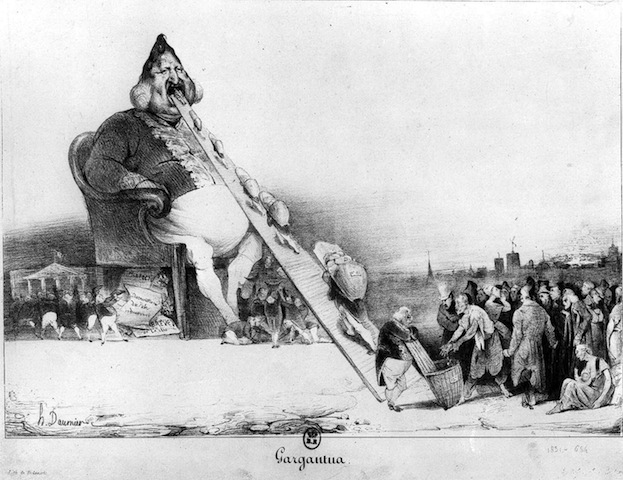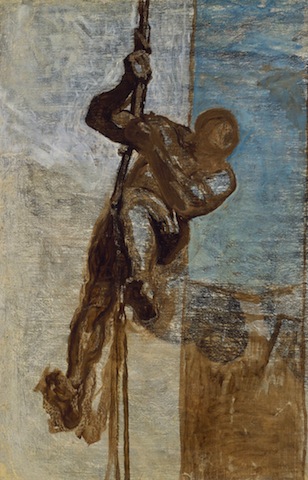Daumier: Visions of Paris, Royal Academy | reviews, news & interviews
Daumier: Visions of Paris, Royal Academy
Daumier: Visions of Paris, Royal Academy
An exhilarating survey of the French caricaturist and painter

From Hogarth through to Gillray and Cruikshank, it was Georgian England that gave rise to a graphic tradition of satire. The powerful were lampooned and the pretensions and avarice of the upper and aspiring classes duly ridiculed. But the poor did not escape moral censure. Far from it. Then as now we had the virtuous and the feckless poor, and it was the love of gin that often bought the latter down.
But as biting caricature in England waned, giving way to the more genteel illustrations of the Victorian era, one figure in France was to dominate the form: Honoré Daumier, whom Baudelaire – that champion of French 19th-century modernism – compared to a pictorial Balzac. Like Hogarth, though rather more so, Daumier came from an impoverished background but he lacked the Englishman’s conservative tendencies. A staunch Republican in post-Napoleonic France, Daumier attacked the powerful, but also championed the poor. And he paid a price for it. For one particularly scurrilous lithograph he was imprisoned for six months. The print in question, which appeared in Charles Philipon’s satirical journal La Caricature in 1831, depicts King Louis-Philippe as Gargantua (pictured below; private collection), hungrily consuming sacks of money through a gaping mouth from which a long ramp descends. Up the ramp, ranks of the labouring poor carry the cash-filled sacks on bent backs.
 Daumier spent a lifetime as a caricaturist. But after that episode his illustrations grew more subtle as censorship laws (after initial liberalisation) were once again tightened. He produced around 4000 lithographs in all, so the Royal Academy’s wonderful exhibition only contains a fraction. Here is the infamous Gargantua, as well as a remarkable lithograph of François Guizot, the king’s interior minister, who Victor Hugo once said reminded him of “an honest woman running a brothel”. Through his awkward demeanour and meditative gaze, Daumier captures complexity and contradiction, while still managing to make Guizot look like a crook.
Daumier spent a lifetime as a caricaturist. But after that episode his illustrations grew more subtle as censorship laws (after initial liberalisation) were once again tightened. He produced around 4000 lithographs in all, so the Royal Academy’s wonderful exhibition only contains a fraction. Here is the infamous Gargantua, as well as a remarkable lithograph of François Guizot, the king’s interior minister, who Victor Hugo once said reminded him of “an honest woman running a brothel”. Through his awkward demeanour and meditative gaze, Daumier captures complexity and contradiction, while still managing to make Guizot look like a crook.
The exhibition gives equal weight to Daumier’s paintings, emphasising the fact that he was part of an artistic milieu in Paris, even though his paintings were little known and rarely exhibited after initial success at the official Salon. The exhibition begins with a shadowy and exquisite little painting by Corot of Daumier working in his studio, painted in 1864, and quotes Baudelaire’s claim that Daumier was one of the most important men “in the whole of modern art”. Certainly later artists tended to agree, with the greatest draughtsmen among them, Degas and Picasso, not only admiring his extraordinary facility as a graphic artist but admiring his focus on realist subject matter. The paintings are a departure from the more allegorical commissioned prints.
 Daumier assiduously observed working people submerged in daily chores and routines before painting them from memory in his studio. Paintings such as The Third-Class Railway Carriage, 1862-64 (main picture), exude great empathy. And one can almost feel the weight of the laundress’s burden in a series of sketchy paintings that feature a young woman heaving her load while leaning into the wind as she makes her way down a street with a young child in tow.
Daumier assiduously observed working people submerged in daily chores and routines before painting them from memory in his studio. Paintings such as The Third-Class Railway Carriage, 1862-64 (main picture), exude great empathy. And one can almost feel the weight of the laundress’s burden in a series of sketchy paintings that feature a young woman heaving her load while leaning into the wind as she makes her way down a street with a young child in tow.
There is something beguiling, as well as rather mysterious, about his paintings, since many were left unfinished, abandoned, including Man on a Rope, c.1858-60 (pictured right; Museum of Fine Arts, Boston. Tompkins Collection). Is this shadowy figure an acrobat, a labourer, an escapee from a crime scene? And what is his gaze fixed upon as he dangles from the rope – the dangerous drop, or a gawping crowd? We have little to go on, but what really captures the modern imagination is the unfinished immediacy of the rough-hewn paint. Similarly, the ghost of the figure of Don Quixote Reading, c.1865-67 seated in a dark and bare room, observed by one, possibly two indistinct figures in a doorway.
Fascinating too, are the hand-sized busts modelled in clay, which Daumier made to assist him with his lithographs. These are of prominent figures in Louis-Philippe’s government, and their comically exaggerated features are finely and delicately rendered. Here is one with his head leaning to one side, appearing placid and reasonable, weighing up this and that; beside him is another who is stout and ruddy of face, bullish and uncompromising; and there another whose face is raised to the heavens, his eyes like a new-born kitten’s and with a childlike smile playing on withered lips, suggesting either dementia or someone with his head in the clouds and trying to reason with the angels.
- Daumier: Visions of Paris at the Royal Academy untl 26 January 2014
Explore topics
Share this article
The future of Arts Journalism
You can stop theartsdesk.com closing!
We urgently need financing to survive. Our fundraising drive has thus far raised £33,000 but we need to reach £100,000 or we will be forced to close. Please contribute here: https://gofund.me/c3f6033d
And if you can forward this information to anyone who might assist, we’d be grateful.

Subscribe to theartsdesk.com
Thank you for continuing to read our work on theartsdesk.com. For unlimited access to every article in its entirety, including our archive of more than 15,000 pieces, we're asking for £5 per month or £40 per year. We feel it's a very good deal, and hope you do too.
To take a subscription now simply click here.
And if you're looking for that extra gift for a friend or family member, why not treat them to a theartsdesk.com gift subscription?
more Visual arts
 Help to give theartsdesk a future!
Support our GoFundMe appeal
Help to give theartsdesk a future!
Support our GoFundMe appeal
 Ed Atkins, Tate Britain review - hiding behind computer generated doppelgängers
Emotions too raw to explore
Ed Atkins, Tate Britain review - hiding behind computer generated doppelgängers
Emotions too raw to explore
 Echoes: Stone Circles, Community and Heritage, Stonehenge Visitor Centre review - young photographers explore ancient resonances
The ancient monument opens its first exhibition of new photography
Echoes: Stone Circles, Community and Heritage, Stonehenge Visitor Centre review - young photographers explore ancient resonances
The ancient monument opens its first exhibition of new photography
 Hylozoic/Desires: Salt Cosmologies, Somerset House and The Hedge of Halomancy, Tate Britain review - the power of white powder
A strong message diluted by space and time
Hylozoic/Desires: Salt Cosmologies, Somerset House and The Hedge of Halomancy, Tate Britain review - the power of white powder
A strong message diluted by space and time
 Mickalene Thomas, All About Love, Hayward Gallery review - all that glitters
The shock of the glue: rhinestones to the ready
Mickalene Thomas, All About Love, Hayward Gallery review - all that glitters
The shock of the glue: rhinestones to the ready
 Interview: Polar photographer Sebastian Copeland talks about the dramatic changes in the Arctic
An ominous shift has come with dark patches appearing on the Greenland ice sheet
Interview: Polar photographer Sebastian Copeland talks about the dramatic changes in the Arctic
An ominous shift has come with dark patches appearing on the Greenland ice sheet
 Donald Rodney: Visceral Canker, Whitechapel Gallery review - absence made powerfully present
Illness as a drive to creativity
Donald Rodney: Visceral Canker, Whitechapel Gallery review - absence made powerfully present
Illness as a drive to creativity
 Noah Davis, Barbican review - the ordinary made strangely compelling
A voice from the margins
Noah Davis, Barbican review - the ordinary made strangely compelling
A voice from the margins
 Best of 2024: Visual Arts
A great year for women artists
Best of 2024: Visual Arts
A great year for women artists
 Electric Dreams: Art and Technology Before the Internet, Tate Modern review - an exhaustive and exhausting show
Flashing lights, beeps and buzzes are diverting, but quickly pall
Electric Dreams: Art and Technology Before the Internet, Tate Modern review - an exhaustive and exhausting show
Flashing lights, beeps and buzzes are diverting, but quickly pall
 ARK: United States V by Laurie Anderson, Aviva Studios, Manchester review - a vessel for the thoughts and imaginings of a lifetime
Despite anticipating disaster, this mesmerising voyage is full of hope
ARK: United States V by Laurie Anderson, Aviva Studios, Manchester review - a vessel for the thoughts and imaginings of a lifetime
Despite anticipating disaster, this mesmerising voyage is full of hope

Add comment